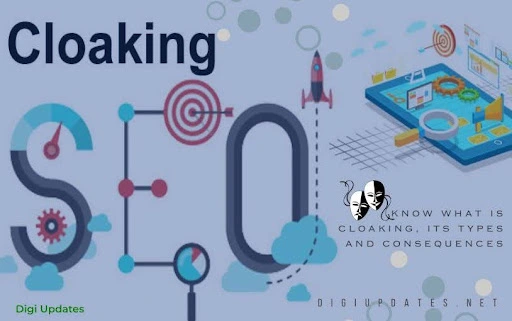Cloaking in SEO: Deceiving Search Engines

In the kingdom of SEO, where ranking high is the ultimate goal, some black hat tactics lurk in the shadows. One such tactic, cloaking, attempts to manipulate search engines by presenting different content to bots and users.
This deceptive practice might offer a temporary ranking boost, but its consequences can be severe, ultimately harming your website’s reputation and traffic. Let’s delve into the murky world of cloaking, unveil its types and examples, and provide valuable insights to steer clear of it.
What is Cloaking in SEO?
We, Digiupdates, define Cloaking as essentially involving presenting two versions of a webpage: one for search engine crawlers and another for human visitors. This is achieved through various techniques, like:
- JavaScript rendering: The content visible to users is dynamically loaded through JavaScript, which search engine bots might not be able to process.
- IP address filtering: Different content is displayed based on the IP address accessing the page, with search engines often having specific IP ranges.
- User-agent detection: The server identifies the user agent (bot or browser) and delivers different content depending on the type.
What are the Types of Cloaking?
Cloaking comes in various flavors, each with its own level of deceitfulness:
- White hat cloaking: This involves dynamically displaying content based on a user’s device or location, offering a better user experience. While technically cloaking, it’s generally not considered against search engine guidelines as it prioritizes user experience.
- Grey hat cloaking: This involves showing slightly different content to users and search engines, like hiding irrelevant advertisements or optimizing content for bots. While not explicitly prohibited, it can trigger penalties if deemed manipulative.
- Black hat cloaking: This involves blatantly deceiving search engines with completely different content, aiming to exploit ranking algorithms. This is a severe violation of search engine guidelines and can result in heavy penalties, including website de-indexing.
Examples of Cloaking in SEO:
Imagine a website selling sports equipment. They might:
- Black hat: Show keyword-stuffed content to bots about popular brands they don’t actually sell while displaying only their own lesser-known brands to users.
- Grey hat: Display a mobile-optimized page with fewer images to bots, improving loading speed and SEO, while presenting a visually rich version to users.
- White hat: Redirect mobile users to a mobile-friendly version of the page for a better browsing experience.
Ethical SEO Path:
Avoiding cloaking and adhering to ethical SEO practices is crucial for long-term success. Here’s how to steer clear of trouble:
- Focus on high-quality content: Create valuable, informative content that caters to your target audience, naturally attracting both users and search engines.
- Optimize for all users: Prioritize a user-friendly experience across all devices and platforms. Mobile responsiveness is a must in today’s mobile-first world.
- Embrace transparency: Don’t try to deceive search engines or users. Authenticity and ethical practices build trust and long-term success.
- Stay updated with guidelines: Search engine guidelines evolve, so keep yourself informed to avoid unintentional infractions.
FAQs:
Q: Can white hat cloaking still get me penalized?
A: While generally tolerated, excessive white hat cloaking can raise flags if it appears manipulative or hinders user experience.
Q: How can I check if my website is cloaked?
A: Use online tools like Google Search Console’s “Fetch as Google” feature or inspect your website code for suspicious practices.
Q: What happens if I get caught cloaking?
A: Penalties can range from ranking drops to complete de-indexing from search results. The severity depends on the type and extent of cloaking.
Understanding and avoiding cloaking is essential for ethical and sustainable SEO practices. Subscribe to Digiupdates.net for insightful blog posts, industry news, and expert advice to navigate the ever-evolving SEO landscape.
Remember, true success lies in building a website that not only ranks high but also offers a genuine and valuable experience to its users. Let’s work together to build a brighter, more ethical future for SEO!




